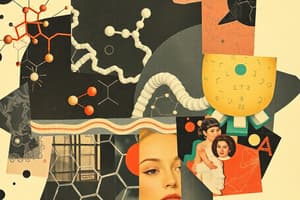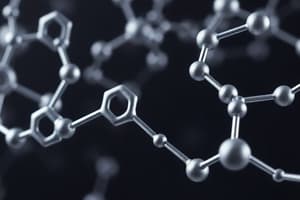Podcast
Questions and Answers
What primarily influences the degree of rotation around a peptide bond?
What primarily influences the degree of rotation around a peptide bond?
- The size of the R groups of the amino acids (correct)
- The presence of metal ions
- The temperature of the solution
- The pH of the environment
Which type of interaction occurs spontaneously to avoid water and typically resides in the core of proteins?
Which type of interaction occurs spontaneously to avoid water and typically resides in the core of proteins?
- Electrostatic interactions
- Disulfide bonds
- Hydrogen bond
- Hydrophobic interactions (correct)
Which structure is characterized by the association of two or more polypeptide chains?
Which structure is characterized by the association of two or more polypeptide chains?
- Quaternary structure (correct)
- Tertiary structure
- Secondary structure
- Primary structure
What type of interaction involves weak, transient attractions between fluctuating electron clouds?
What type of interaction involves weak, transient attractions between fluctuating electron clouds?
What term is used for a protein made up of two identical subunits?
What term is used for a protein made up of two identical subunits?
What primarily determines the secondary structure of a polypeptide chain?
What primarily determines the secondary structure of a polypeptide chain?
Which of the following best describes tertiary structure in proteins?
Which of the following best describes tertiary structure in proteins?
In which structural feature do parallel and anti-parallel orientations occur?
In which structural feature do parallel and anti-parallel orientations occur?
Which protein structure includes the association of multiple polypeptide chains?
Which protein structure includes the association of multiple polypeptide chains?
Which statement about alpha helices is true?
Which statement about alpha helices is true?
Which amino acids are primarily found on the surface of globular proteins?
Which amino acids are primarily found on the surface of globular proteins?
Which protein structure is most often found in the interior of globular proteins?
Which protein structure is most often found in the interior of globular proteins?
What defines super secondary structures in proteins?
What defines super secondary structures in proteins?
What type of amino acids are characterized by having a cyclic R group?
What type of amino acids are characterized by having a cyclic R group?
Which category of amino acids is characterized by containing a hydroxyl group?
Which category of amino acids is characterized by containing a hydroxyl group?
What is the primary structure of a protein?
What is the primary structure of a protein?
How do aromatic amino acids contribute to biochemical analysis?
How do aromatic amino acids contribute to biochemical analysis?
What characteristic allows amino acids to exist as zwitterions?
What characteristic allows amino acids to exist as zwitterions?
Which of the following statements about proteins is correct?
Which of the following statements about proteins is correct?
How are amino acids classified based on their R group?
How are amino acids classified based on their R group?
What is true regarding the solubility of aliphatic amino acids?
What is true regarding the solubility of aliphatic amino acids?
Flashcards
Peptide Bond Rotation
Peptide Bond Rotation
The degree of rotation depends on the size of R groups in amino acids, limited by double bond characteristics.
Hydrophobic Interactions
Hydrophobic Interactions
Interactions between hydrophobic side chains that avoid water, stabilizing proteins usually in their core.
Electrostatic Interactions
Electrostatic Interactions
Attractions between charged side chains, such as COO- and NH+ groups, stabilizing protein structure.
Van der Waals Interactions
Van der Waals Interactions
Signup and view all the flashcards
Quaternary Structure
Quaternary Structure
Signup and view all the flashcards
Secondary Structure
Secondary Structure
Signup and view all the flashcards
Super Secondary Structures
Super Secondary Structures
Signup and view all the flashcards
Tertiary Structure
Tertiary Structure
Signup and view all the flashcards
Alpha Helix
Alpha Helix
Signup and view all the flashcards
Beta Structure
Beta Structure
Signup and view all the flashcards
Hydrophobic Amino Acids
Hydrophobic Amino Acids
Signup and view all the flashcards
Peptide Bond Geometry
Peptide Bond Geometry
Signup and view all the flashcards
Amino Acid
Amino Acid
Signup and view all the flashcards
Classification of Amino Acids
Classification of Amino Acids
Signup and view all the flashcards
Polar Amino Acids
Polar Amino Acids
Signup and view all the flashcards
Zwitterions
Zwitterions
Signup and view all the flashcards
Aromatic Amino Acids
Aromatic Amino Acids
Signup and view all the flashcards
Globular vs Fibrous Proteins
Globular vs Fibrous Proteins
Signup and view all the flashcards
Primary Structure of Proteins
Primary Structure of Proteins
Signup and view all the flashcards
Study Notes
Amino Acids & Proteins
- Amino acids are the basic units of proteins.
- Each amino acid has a central carbon atom (α carbon).
- Attached to this carbon are an amino group (+NH₃), a carboxyl group (-COOH), a hydrogen atom, and a variable R-group (side chain).
- The R-group determines the specific properties of each amino acid.
- Stereoisomerism (D/L): L-amino acids are the building blocks of proteins in most organisms. D-amino acids are found in some bacterial cell walls and peptide antibiotics.
- Classification of amino acids is based on the chemical properties of their R-groups, including whether they are polar or nonpolar, acidic or basic.
- Hydrophobic or nonpolar
- Polar and uncharged
- Polar and negatively charged
- Polar and positively charged
- Amino acids can be classified by their R-group types, such as:
- Aliphatic (leu, ile, ala, val)
- Aromatic (phe, trp, tyr)
- Containing sulfur (cys, met)
- Containing hydroxyl (thr, ser)
- Acidic (asp, glu)
- Basic (lys, arg, his)
- Imino (pro)
- Amides (Gln, Asn)
- Many naturally occurring amino acids are hydrophobic, including:
- Leu, Ile, Ala, Val, Met, Phe, Trp, Pro.
- Some examples of polar, uncharged amino acids include:
- Ser, Thr, Tyr, Cys, Gln, Asn.
- Some examples of polar, charged amino acids include:
- Asp, Glu, Lys, Arg, His.
- Proteins are biopolymers of amino acids.
- Proteins vary greatly in size; some have 1000–2000 amino acids (e.g., collagen).
- Smaller polypeptides have less than 100 amino acids (e.g., insulin has 51 amino acids).
- The structure of amino acids.
- Some other properties of amino acids.
Protein Structure
- Proteins are biopolymers of amino acids.
- Large proteins have 1000-2000 amino acids, like collagen.
- Some proteins are smaller, like insulin (51 amino acids).
- Myoglobin (153 amino acids), ADH (374 amino acids), and hemoglobin (574 amino acids) are examples of medium-sized proteins.
- Proteins are categorized as globular or fibrous.
- Proteins can function as enzymes, structural components, for transport, and as hormones.
- Conjugated proteins have a non-protein moiety (e.g., heme in hemoglobin).
Organizational Levels in Protein Structure
- Primary structure: The linear sequence of amino acids in a protein.
- Secondary structure: Local conformations of the polypeptide chain, such as α-helices and β-sheets due to hydrogen bonds between backbone atoms without side-chain participation.
- Super Secondary Structures: Arrangement of secondary structures.
- Tertiary structure: The 3-D configuration of the entire polypeptide chain arising from interactions of amino acids far apart in the primary sequence. This includes hydrogen bonds, hydrophobic interactions, ionic bonds, disulfide bonds and van der Waals forces.
- Quaternary structure: The overall arrangement of multiple polypeptide chains (subunits) to form a larger, functional protein.
- Some proteins exist as single polypeptide chains, while others consist of multiple polypeptide chains joined to create a larger, functional protein.
Secondary Structures
- α-helix: A common secondary structure.
- A lot of hydrogen bonding between carbonyl oxygen and amide hydrogens of amino acids separated by four residues.
- Right-handed helix.
- ~11 amino acid residues per turn in globular proteins.
- β-structure: Another common secondary structure.
- Many hydrogen bonds between neighboring peptide bonds in parallel or anti-parallel polypeptide chains.
- β-pleated sheet structure.
- 2 to 15 amino acids per turn.
Tertiary Structures
- Important aspects of the 3-D structure of a particular protein/polypeptide and some proteins include the arrangement of secondary structures.
- Super secondary structures or motifs.
- Average 27% are alpha helix and 23% beta structure but there are exceptions, such as in myoglobin and hemoglobin (75-80% α-helix).
- In some proteins, there are no α-helices, like in Concanavalin A (all β-structures).
- Some examples of proteins with mostly beta sheets include Concanavalin A, lectin.
Tertiary Structures (cont.)
- Hydrophobic amino acids are usually found in the interior of proteins.
- Polar and charged amino acids are usually found on the protein surface to interact with water.
- Large globular proteins (>200 amino acids) often have domains with specific functions (e.g., domains in enzymes like glyceraldehyde-3-P dehydrogenase, or phosphoglycerate kinase).
Forces That Influence Protein Structure
- Peptide bond geometry: The C=O and C-N atoms are planar due to partial double bond character, limiting rotation and influencing protein conformation.
- Hydrogen bonds: Form between peptide backbone groups.
- Hydrophobic interactions: Drive hydrophobic side chains to cluster in the protein interior away from water.
- Electrostatic interactions: Occur between charged side chains (ionic bonds).
- Van der Waals interactions: Relatively weak attractions between non-polar side chains.
- Disulfide bonds: Covalent bonds between cysteine side chains stabilizing protein structure.
Quaternary Structures
- The fourth level of protein structure is concerned with the interaction and association of two or more polypeptide chains to form a larger functional protein molecule.
- Polypeptide chains are called subunits or monomers.
- The geometry of the molecule is its quaternary structure.
- Examples include proteins with multiple identical subunits (homogeneous), like muscle creatine kinase. Hemoglobin is heterogeneous with 2 alpha and 2 beta subunits.
Studying That Suits You
Use AI to generate personalized quizzes and flashcards to suit your learning preferences.




